中国典籍英译概述57页PPT
汉语典籍英译的标准与策略讲义
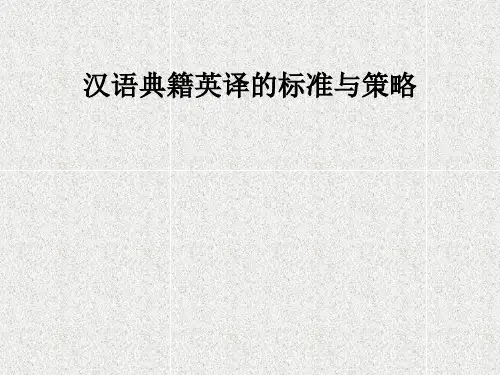
3、典籍英译的分类
中国古典散文、诗歌、小说、戏剧以及科技作品; 具体有:《老子》、《易经》、《庄子》、《墨子》、《诗经》、《汉魏六朝诗三百首》、《孔雀东南飞·木兰诗》、《英译陶诗》、《红楼梦》、《水浒传》、
《西游记》、《三国演义》、《牡丹亭》、《邯郸记》、《紫钗记》、《南柯记》、《梦溪笔谈》、《山海经》、《天工开物》、《茶经》、《黄帝内 经·素问》等
1)19世纪末至20世纪初,以英国为中心;20世纪 中叶,以美国为中心;20世纪末至21世纪初,随 着中国国力的增强,逐渐转变为以中国为中心。
2) 中国典籍英译已经由以译介为主发展到翻译和研 究并重。
3)在继承和创新方面,新的研究方法的流行与继承 传统的努力已形成鲜明对照,许多学者大胆尝试 新的研究方法,西论中用已成为中国典籍英译标 准与策略研究的一大特色。
典籍英译作品分为严格意义的翻译 ( ) 和宽泛意 义上的翻译 ( )。前者在内容、形式、功能和文 体等方面与原文高度一致或接近,后者则在内容、 形式、功能和文体等方面与原文有明显变异。
从事严格意义的翻译时,译者需要尽量抵制权力关 系、意识形态、社会、政治、文化因素等对翻译 过程的操控,尽力向原文文本靠拢;从事宽泛意 义的翻译,译者则需顺应权力关系、意识形态、 社会、政治、文化因素等对翻译过程的操控,与 原文文本保持一定距离。
汉语典籍英译的标准与策略
• 天净沙·秋思 • 枯藤 • 老树 • 昏鸦。 • 小桥 • 流水 • 人家。 • 古道西风瘦马。 • 夕阳西下, • 断肠人 • 在天涯。
•, •A , •, a • •A
天净沙·秋思 马致远
1、引言
中国典籍英译队伍主要由海外译者(包括 华裔译者)和中国译者两部分人组成。
理
汉语典籍英译的标准与策略讲义PPT课件(46页)
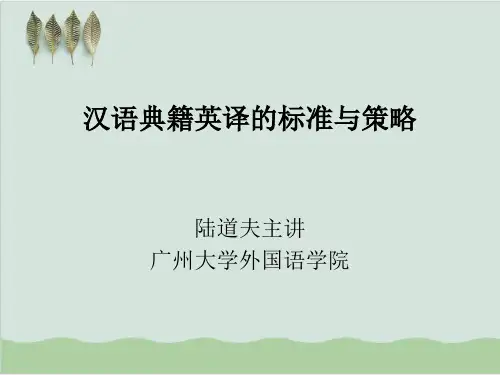
• 此句许渊冲译成:
• In eighth moon down the dates we beat. (八月 打下大红枣。)
• 下面两个句子中的“说”字也是通假字,如何译?
• (1)成事不说,遂事不谏,既往不咎。(《论语·八 佾》)。
需了解译本读者是国内读者还是国外读者,是普 通读者还是从事中国文化研究的人士。针对不同 读者,显然应该采取不同的翻译标准和翻译策略, 以适应他们的需求,在尽量贴近原文和适度背离 原文之间做出选择。因此,应加强对译文读者需 求的研究。
3、典籍英译的分类
中国古典散文、诗歌、小说、戏剧以及科技作品;
具体有:《老子》、《易经》、《庄子》、《墨 子》、《诗经》、《汉魏六朝诗三百首》、《孔 雀东南飞·木兰诗》、《英译陶诗》、《红楼梦》、 《水浒传》、《西游记》、《三国演义》、《牡 丹亭》、《邯郸记》、《紫钗记》、《南柯记》、 《梦溪笔谈》、《山海经》、《天工开物》、 《茶经》、《黄帝内经·素问》等
二、典籍英译的难处
• 1、译语中无对等词 (Equivalent) • 这种情况常可遇见。通常有四种处理策略: • 一是用近义词语加注解; • 二是将近义词大写使之专有化; • 三是音译加注解; • 四是造词。 • 道:Tao 《道德经》 Tao Te Ching • 无名:The Nameless • 有名:The Named
☆ “形离神离”(内容不忠实、效果不对等)。
☆ 典籍英译标准要探讨原文与译文在意义、长度、 体裁、风格、功能等的相似和差异关系,重视对 非文学类的典籍作品、摘译本、节译本翻译标准 的摘译本、节译本研究。
典籍英译作品分为严格意义的翻译 (translation in the strict sense) 和宽泛意义上的翻译 (translation in the broad sense)。前者在内容、形式、功能和 文体等方面与原文高度一致或接近,后者则在内 容、形式、功能和文体等方面与原文有明显变异。
汉语典籍英译的标准与策略讲义(ppt 46页)
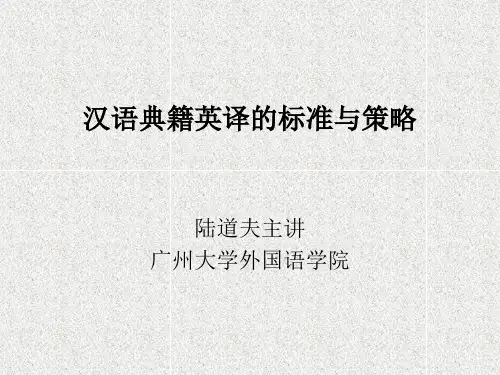
翻译的标准?
不同时代、不同文化背景的不同译者往往有不同 的翻译理念和不同的读者群,因而采取不同的翻 译标准和翻译策略。
不同的翻译标准和翻译策略的制订涉及译者对翻 译的理解、译入语文化的规约、译文读者的需求、 原文文本类型等
针对中国典籍作品的不同文体,国内一些学者曾 提出过一些具体的翻译标准。 如:译文要三美(音美、意美、形美),
Limited, 1925)
• 《西游记》
• 1)Journey to the West • (W. J. F. Jenner, 外文出版社,1980) • Havoc in Heaven, Adventures of the Monkey
King • 2)The Pilgrimage to the West • 3)The Monkey King • 4)Monkey (Arthur Waley, 1942)
译文要“明白、通畅、简洁”等。
典籍英译译者的翻译目的有什么不同? 译文读者需求有什么不同? 典籍文本类型有什么不同?
2、 “怎么译”?
要回答该问题,需要厘清: 所涉典籍英译是严格意义的翻译还是宽泛意义的 翻译? 是文学翻译还是非文学翻译? 译文是针对普通读者还是特殊读者?
其实,怎么译,说到底取决于我们对翻译本体(其 跨语言、跨文化属性)、翻译客体(原文和译文 之间的关系)以及翻译主体(译者权限)的深化 认识。
• 《论语》The Confucian Analects/
•
The Analects of Confucius
• 《孟子》 (The Works of) Mencius
• 据称它们分别出于早期儒家的四位代表性人物曾参、 子思、孔子、孟子,所以称为《四子书》(也称 《四子》),简称为《四书》。
中国文化典籍英译
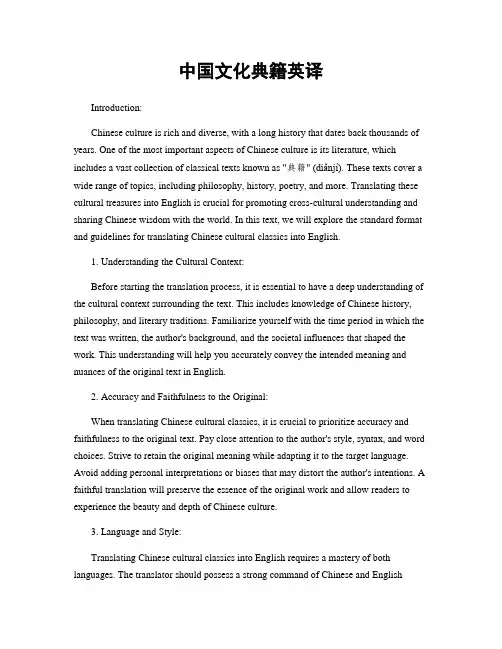
中国文化典籍英译Introduction:Chinese culture is rich and diverse, with a long history that dates back thousands of years. One of the most important aspects of Chinese culture is its literature, which includes a vast collection of classical texts known as "典籍" (diǎnjí). These texts cover a wide range of topics, including philosophy, history, poetry, and more. Translating these cultural treasures into English is crucial for promoting cross-cultural understanding and sharing Chinese wisdom with the world. In this text, we will explore the standard format and guidelines for translating Chinese cultural classics into English.1. Understanding the Cultural Context:Before starting the translation process, it is essential to have a deep understanding of the cultural context surrounding the text. This includes knowledge of Chinese history, philosophy, and literary traditions. Familiarize yourself with the time period in which the text was written, the author's background, and the societal influences that shaped the work. This understanding will help you accurately convey the intended meaning and nuances of the original text in English.2. Accuracy and Faithfulness to the Original:When translating Chinese cultural classics, it is crucial to prioritize accuracy and faithfulness to the original text. Pay close attention to the author's style, syntax, and word choices. Strive to retain the original meaning while adapting it to the target language. Avoid adding personal interpretations or biases that may distort the author's intentions. A faithful translation will preserve the essence of the original work and allow readers to experience the beauty and depth of Chinese culture.3. Language and Style:Translating Chinese cultural classics into English requires a mastery of both languages. The translator should possess a strong command of Chinese and Englishgrammar, vocabulary, and syntax. It is important to choose appropriate English equivalents for Chinese idioms, metaphors, and cultural references. Consider the target audience and aim for a style that is accessible and engaging. Maintain a balance between preserving the original text's literary qualities and ensuring readability for English-speaking readers.4. Footnotes and Annotations:Chinese cultural classics often contain references to historical events, figures, and cultural practices that may be unfamiliar to non-Chinese readers. To provide necessary context and enhance understanding, footnotes and annotations can be added to the translated text. Footnotes should be concise and provide explanations or additional information without interrupting the flow of the main text. Annotations can be used for more extensive explanations or discussions of specific cultural elements.5. Consistency and Coherence:Maintaining consistency and coherence throughout the translation is essential. Use consistent terminology for recurring concepts, names, and phrases. Pay attention to the logical flow of ideas and ensure that the translated text reads smoothly and coherently. Consider the overall structure of the text and how individual sections relate to each other.A well-structured translation will help readers navigate the complexities of the original work and fully appreciate its cultural significance.6. Editing and Proofreading:Once the translation is complete, thorough editing and proofreading are necessary to ensure accuracy and quality. Review the translated text for any grammatical errors, typos, or inconsistencies. Verify that the translation accurately reflects the original text's meaning and intent. Consider seeking feedback from native speakers or experts in the field to further refine the translation. A well-edited and polished translation will enhance its credibility and readability.Conclusion:Translating Chinese cultural classics into English is a challenging yet rewarding endeavor. It requires a deep understanding of both Chinese and English languages, as well as a profound knowledge of Chinese history and culture. By following the standard format and guidelines outlined above, translators can accurately convey the beauty and wisdom of Chinese literature to a global audience. Through these translations, we can bridge cultural gaps and foster a greater appreciation for the richness of Chinese culture.。
中国文化典籍英译
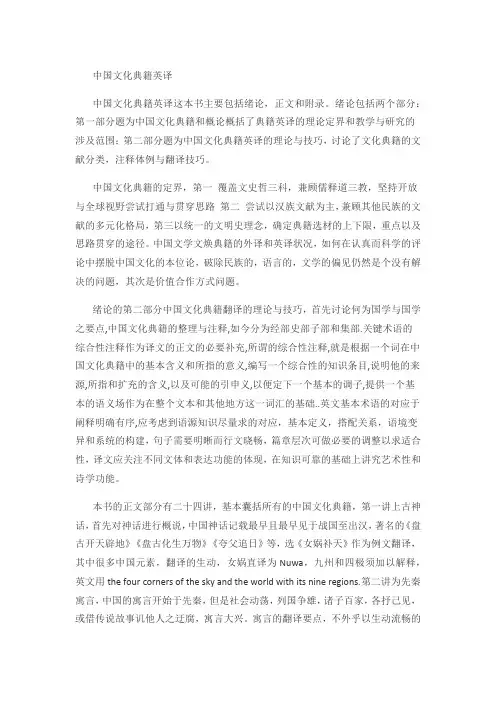
中国文化典籍英译中国文化典籍英译这本书主要包括绪论,正文和附录。
绪论包括两个部分:第一部分题为中国文化典籍和概论概括了典籍英译的理论定界和教学与研究的涉及范围;第二部分题为中国文化典籍英译的理论与技巧,讨论了文化典籍的文献分类,注释体例与翻译技巧。
中国文化典籍的定界,第一覆盖文史哲三科,兼顾儒释道三教,坚持开放与全球视野尝试打通与贯穿思路第二尝试以汉族文献为主,兼顾其他民族的文献的多元化格局,第三以统一的文明史理念,确定典籍选材的上下限,重点以及思路贯穿的途径。
中国文学文焕典籍的外译和英译状况,如何在认真而科学的评论中摆脱中国文化的本位论,破除民族的,语言的,文学的偏见仍然是个没有解决的问题,其次是价值合作方式问题。
绪论的第二部分中国文化典籍翻译的理论与技巧,首先讨论何为国学与国学之要点,中国文化典籍的整理与注释,如今分为经部史部子部和集部.关键术语的综合性注释作为译文的正文的必要补充,所谓的综合性注释,就是根据一个词在中国文化典籍中的基本含义和所指的意义,编写一个综合性的知识条目,说明他的来源,所指和扩充的含义,以及可能的引申义,以便定下一个基本的调子,提供一个基本的语义场作为在整个文本和其他地方这一词汇的基础..英文基本术语的对应于阐释明确有序,应考虑到语源知识尽量求的对应,基本定义,搭配关系,语境变异和系统的构建,句子需要明晰而行文晓畅,篇章层次可做必要的调整以求适合性,译文应关注不同文体和表达功能的体现,在知识可靠的基础上讲究艺术性和诗学功能。
本书的正文部分有二十四讲,基本囊括所有的中国文化典籍,第一讲上古神话,首先对神话进行概说,中国神话记载最早且最早见于战国至出汉,著名的《盘古开天辟地》《盘古化生万物》《夸父追日》等,选《女娲补天》作为例文翻译,其中很多中国元素,翻译的生动,女娲直译为Nuwa,九州和四极须加以解释,英文用the four corners of the sky and the world with its nine regions.第二讲为先秦寓言,中国的寓言开始于先秦,但是社会动荡,列国争雄,诸子百家,各抒己见,或借传说故事讥他人之迂腐,寓言大兴。
中国古代传说故事英文翻译及讲解(课堂PPT)
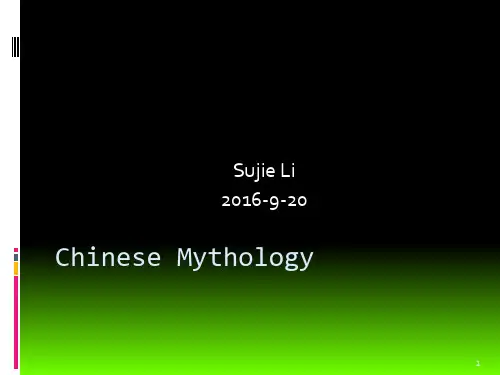
▪Shennong tasting all kinds of grass and plants,
▪Yu taming the flood …
11
3. They extol perseverance and self-sacrifice. ▪The story of Gun and Yu trying to tame the flood ▪“The Foolish Old Man Removes the Mountain” 4. They praise rebellion against oppression. 5. They eulogize the yearning for true love.
10
General features of Chinese ancient myths
1. Mythical stories are entwined with history.
▪Fuxi, Shennong, Huangdi, Yu are both historical figures according to legend and important characters in mythical stories.
8
Chinese myths you know of…
9
General intro. of Chinese Myths
▪ Ancient Chinese myths were not recorded in a systematic way in any work, and only fragments of them are extant today.
16
精卫填海 Jingwei determines to fill
中国文化--英文版PPT课件
反映了中国古代天人合一思想,确立了中医学独特的 理论体系, 成为中国医药学发展的理论基础和源泉。
Huangdi Neijing , also known as The Inner Canon(教 规) of Huangdi or Yellow Emperor's Inner Canon, is an ancient Chinese medical text that has been treated as the fundamental doctrinal source for Chinese medicine for more than two millennia.
Classic on Medical Problems
《难经》,原名《黄帝八十一难经》,传 说为战国时秦越人(扁鹊)所作。本书以 问答解释疑难的形式编撰而成,共讨论了81 个问题,故又称《八十一难》,全书所述 以基础理论为主,还分析了一些病证。
其中一至二十二难为脉学,二十三至二十 九难为经络,三十至四十七难为脏腑,四 十八至六十一难为疾病,六十二至六十八 为腧穴,六十九至八十一难为针法。
太难了,没找到英文的资料
Treatise on Febrile and Miscellaneous Diseases
《伤寒杂病论》,又作《伤寒卒病论》,为东 汉张仲景所著,是中国第一部理法方药皆备、 理论联系实际的中医临床著作。
此书被认为是汉医学之内科学经典,奠定了中 医学的基础。
因为历史因素,本书原貌不复可见,后世分成 《伤寒论》与《金匮要略》两书,分别流通。
中国典籍英译概述
▪ 理雅各(James Legge, 1815-1897)
英国汉学三大星座之一, 第一位系统研究、翻译 中国古代经典的英国著 名汉学家。曾任香港英 华书院院长,伦敦布道 会传教士。
从1861年到1886年的25年间,在中国学者王韬的帮助下,理雅 各陆续翻译出版了中国的《论语》、《大学》、《中庸》、《孟子》、 《春秋》、《礼记》、《书经》、《孝经》、《易经》、《诗经》、 《道德经》、《庄子》等名著,取名《中国经典》共计28卷。在整 个翻译过程中,理雅各治学严谨,除了认真参考和吸取王韬的研究成 果外,他十分注重旁征博采,力求持之有据,绝不主观臆断。《中国 经典》陆续出版后,在西方引起了轰动,于1876年获法兰西学院儒 莲汉籍国际翻译奖(the First International Stanislas Julien Prize for Chinese Literature)。1873年,理雅各离开香港返回英国,任牛津大 学汉学讲座的第一任教授。理雅各采用语言与文化并重的教学策略和 注重翻译的教学模式。他在牛津大学前后共22年,培养了许多汉学 家。
中国典籍英译概述
一、对于“典籍”的界定
《辞海》(1999年版上卷第831页):国家的重要 文献。
《孟子·告子下》:诸侯之地方百里;不百里,不足 以守宗庙之典籍。(赵岐注:谓先祖常籍法度之 文也。亦统称各种典册、书籍。)
《尚书序》:及秦始皇灭先代典籍。
《后汉书·崔寔传》:少沈静,好典籍。
“典籍”主要有两个义项:一是古代重要文献、 书籍;二是法典、制度。
结论
“典籍”界定为“中国清代末年1911年以前 的重要文献和书籍。”
“重要文献和书籍”是指中国的社会科学、 自然科学等各个领域的典籍作品。不仅包括中国 古典文学作品,而且包括中国古典法律、医药、 经济、军事、天文、地理等诸多方面的作品。
中国典籍英译概述ppt课件
文学
文学方面不仅包括《诗经》、《楚辞》与唐宋
诗词,先秦诸子和唐宋散文、寓言传说与明清小 说、元杂剧和散曲等,而且还包含一些至关重要 的艺术类,例如书法绘画理论的代表性作品。
经营者提供商品或者服务有欺诈行为 的,应 当按照 消费者 的要求 增加赔 偿其受 到的损 失,增 加赔偿 的金额 为消费 者购买 商品的 价款或 接受服 务的费 用
(二)尝试以汉族文献为主,兼顾其他民族文 献的多元文化格局
中国是一个多民族的国家,中华民族多元文化 的共生共存状态是一个不争的事实。由于历史原因, 以往的中国文化史往往讲成了汉族文化的历史,或 者只利于汉语的历史资料,或者围绕汉语和汉族文 化构建历史文化观念,导致一定程度上忽略了其他 民族及其语言的历史和文化特点,其中也包括其他 民族中一些极为重要的历史事实和文化现象。
▪ 自从德庇时 (John Francis Davis, 1795-1890) 翻译的 “好逑传” (Hao Ch’iu Chuan) 1761年首次在英 国出版以来,中国典籍英 译已经走过了250年的历 史(马祖毅,1997:10)。 此外德庇时还翻译了《汉 宫秋》(The Sorrows of Han)。
历史
在历史方面,不但应当包含先秦和汉代历史
著作的精华,如《史记》,而且应当包含一些历 史人物的传记和历史观、历史哲学一类著作,如 康有为的《大同书》等。
经营者提供商品或者服务有欺诈行为 的,应 当按照 消费者 的要求 增加赔 偿其受 到的损 失,增 加赔偿 的金额 为消费 者购买 商品的 价款或 接受服 务的费 用
经营者提供商品或者服务有欺诈行为 的,应 当按照 消费者 的要求 增加赔 偿其受 到的损 失,增 加赔偿 的金额 为消费 者购买 商品的 价款或 接受服 务的费 用
《中国文化概况 英汉对照版 》读书笔记PPT模板思维导图下载
Culinary Cult...
3 三 建筑文化
Architectur e
4 四 行在中国
Tr a v e l i n g in ...
5 课后练习题
Practice
(二)唐装 Tang Costume
(一)汉服 Hanfu
(三)旗袍 Cheongsam
01
(一)筷 子 Chopsti cks
(一)回族 Hui Ethnic Gro...
(三)回族与维 吾尔族的关系 The Re...
第十一章 中国的创造 Chinese C...
一 四大发明 1
Four Great In...
二 大国重器 2
The Pillars o...
3 三 新四大发
明 Four New Gre...
4 四 “黑科技”
06 第六章 中国的政治制 度 Chinese ...
目录
07 第七章 中国人的生活 Chinese D...
09 第九章 中国的国粹 Chinese Qu...
08 第八章 中国的节日 Chinese Fe...
010
第十章 中国的少数民 族 Ethnic M...
目录
011 第十一章 中国的创造 Chinese C...
三 中国人的业余 生活 The Spare...
课后练习题 Practice
(二)从“独生 子女”政策到 “二孩”政策
的...
(一)中国婚礼 Chinese Wedd...
(三)中国人的 餐桌文化 Chinese ...
(二)微信 WeChat
(一)5G生活 5G Life
(三)支付宝 Alipay
